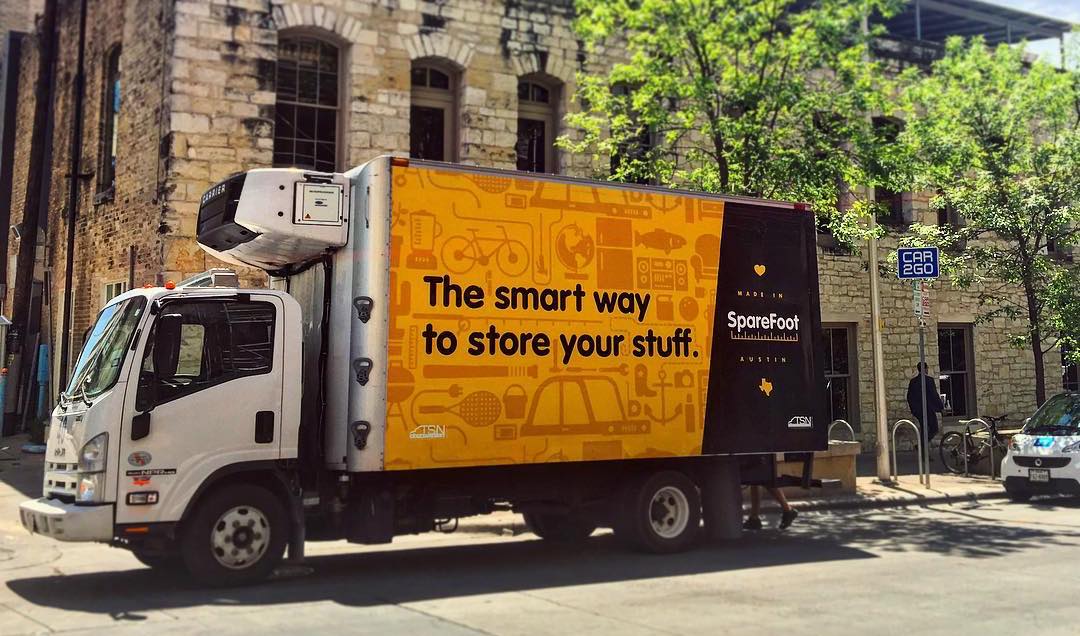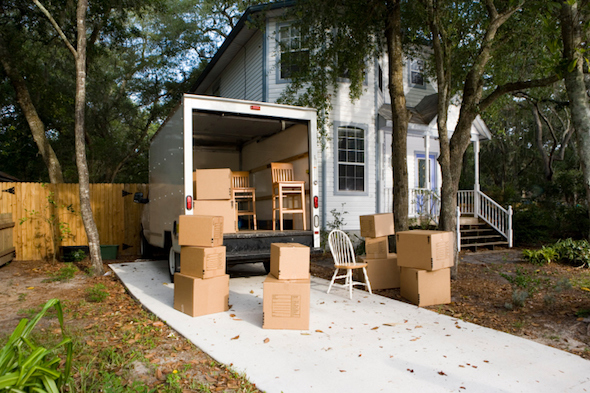Hiring movers can be expensive, and if you’re willing to do the heavy lifting yourself, you could save a buck or two by renting a personal moving truck.
But if you do plan to do it yourself, there is a lot you need to think about. How can I get the best deal? Do I need insurance? What size truck do I need? What should I load first?
While it may seem intimidating, renting a moving truck is actually a snap if you know what you are doing. Keep reading to find out all the answers you need to know for a hassle-free experience.
What Size Moving Truck Do I Need?
The last thing you want to do is rent a truck that’s too small and end up having to make numerous trips. Most truck rental companies will help you determine what size you need based on the items you’re moving or the number of rooms your belongings fit into.
For example, Penske Truck Rental estimates that if you’re moving one to two rooms’ worth of belongings, you’ll need a 12-foot moving truck. Meanwhile, if you’re moving five to seven rooms’ worth of belongings, you’ll need a 26-foot truck. Penske offers a “Truck Wizard” to help you make this determination.
Moving Truck Sizes
Below are the most common moving truck sizes you will encounter. Sizes listed are from Penske and U-Haul, however other truck rental companies will have similar offerings.
- Cargo Van. Offered by U-Haul and Penske. Typically 10 to 11 feet long cargo vans are suitable for moving the contents of a single room, such a dorm room.
- 10 Foot Truck. Offered by U-Haul. Suitable for a single room or studio apartment.
- 12 Foot Truck. Offered by Penske. Holds contents of 1-2 rooms or a one-bedroom apartment
- 15 Foot Truck. Offered by U-Haul. Fits contents of one bedroom home.
- 16 Foot Truck. Offered by Penske. Carries load of 2-3 rooms.
- 20 Foot Truck. Offered by U-Haul. Fits 2 bedroom home
- 22 Foot Truck. Offered by Penske. Fits contents of 3-5 rooms.
- 26 Foot Truck. Offered by U-Haul and Penske. Holds contents of a 3-4 bedroom house.
The 26 foot truck should hold about 1700 cubic feet of household goods, while a cargo van will hold about 400 cubic feet.
If in doubt, rent the larger truck. If you run out of space while loading, you’ll have to make an extra trip or leave some things behind.
How Far in Advance Do I Have to Book a Rental Truck?
People are more likely to move during the summer than other times of the year, so moving trucks may be more difficult to book between Memorial Day and Labor Day. The end of the month is particularly busy, so you might find it hard to get a truck during that period if you wait until the last minute.
To be on the safe side, reserve your truck at least a couple of weeks in advance of moving day.
What Is it Like Driving a Moving Truck?
It’s very important to consider your safety when driving. Before signing a rental agreement, sit in the driver’s seat to make sure you’re comfortable with the size of the vehicle. Box trucks can be intimidating if you have never driven one. If you don’t feel comfortable with a large truck, consider driving a cargo van or pick up truck.
Practice maneuvering the vehicle in an empty parking lot, so you can be prepared when you’re out on the road. Consider the route you’ll be driving and check for low bridge overhangs or detours.
How Do I Find the Best Price on a Moving Truck Rental?
You’ll need three pieces of information to score the best deal possible: the size for the truck you’ll require, the distance you’ll be going and the dates you’ll be moving. Rental truck companies typically charge a daily rate, along with a certain amount per mile. For example, you may be quoted a rate of $29.99 a day in addition to 79 cents per mile.
Pricing also may vary based on the day of the week or the time of the year. You may get a better deal on days when moving trucks are not in high demand, so if you’re flexible, see whether your rate changes if you rent the truck midweek as opposed to over the weekend.
While price should be a factor, it probably isn’t the only one to consider. If you’re moving from one location to another and don’t want to return the truck to the original location, your options may be limited.
Penske offers free unlimited miles on one-way truck rentals anywhere in the United States. Other companies generally charge by the mile for long distance move, but offer a fixed rate for local moves.
Do I Need to Get Rental Truck Insurance?
It’s great to think positively, but you’ve got to weigh what would happen if you were to get into an accident with the rental truck or if your belongings were stolen during the move. When you rent a car with a credit card, your card issuer typically provides rental car insurance, but this isn’t the case with a moving truck; neither Visa nor MasterCard extends that privilege.
Your home and auto insurance policies may provide some coverage, but check with your insurance company to make sure you don’t need supplemental coverage, according to the Insurance Information Institute. Even if your car insurance policy will cover a moving truck, there may be exclusions based on the size, according to the National Association of Insurance Commissioners. For example, a 10-foot truck might be covered under your policy, but a 24-foot truck might not.
Keep in mind that the truck rental company probably sells insurance with these features:
- Damage waivers protect you from forking over money to cover damage to or theft of the moving truck.
- Supplemental liability insurance stops you from paying for property damage and bodily injury claims filed against you.
- Personal and cargo policies protect your property while it’s inside the rental truck.
- Auto tow protection covers damage to or theft of your personal vehicle if you’re towing it on a trailer.
What Do I Need to Do When I Pick Up the Moving Truck?
Here are some other things you need to be aware of:
- Settle on the route that you’ll be driving, since some roads prohibit trucks.
- On the day you rent the truck, you’ll need your driver’s license and a major credit card.
- Before taking off, check the truck to ensure you’re not blamed – and charged – for damage that already existed.
- Make sure that the loading ramp slides out easily and is in working order before you pull away. A busted ramp can ruin your moving day.
Do I Need to Rent Moving Equipment?
You might need more than a moving truck to get your items into your new home. For example, hand trucks are two-wheel carts that make it easier to move heavy furniture and moving boxes. Furniture pads can protect your furniture and your floors during the moving process. Moving equipment is typically not provided for free, you’ll have to pay extra to use them. However, the right equipment will make your DIY move more successful.
How Do I Pack a Moving Truck Correctly?
Not sure how to begin when it comes to packing your belongings? Follow these guidelines to pack like a professional mover.
- Load the heaviest items and appliances into the truck first.
- Pack your heaviest items into the front of the truck to maximize your space and to keep the truck from dragging if the back is too heavy. If the truck drags, you could be in a dangerous driving situation, so it’s best to avoid it.
- For extra protection, after you wrap a mirror or painting, you can put it between your mattress and box spring, or surround it by cushions.
- Wrap up your couch cushions and pillows.
- Place your mattresses inside plastic mattress covers.
- If you plan ahead, you probably have a lot of things that you need to move with you anyway that would make great protective pads in the truck. When packing your house, leave out some older blankets, sheets, towels and other linens so you can use them when packing.
- Move the longer items into the truck. These will pieces of furniture such as your sofas, table-tops, headboards, long mirrors, and your box spring and mattress. Put them against the longest walls of the truck to save space and keep them upright. Secure these items to the side of the truck with ties if it has a place for them.
- Choose boxes of similar size and strength so you can stack them on top of each other. Place the heaviest and largest boxes on the bottom, medium-weight boxes in the middle, and lighter items on top. You will be creating three layers of weight.
- Your goal should be to pack the truck as tightly as possible without squeezing the items together too tightly. Squeeze in any unwieldy items where you can, and place fragile items on top so they don’t get crushed.
- Try to fit together the remaining parts as if you were working on a jigsaw puzzle. Everything will be able to fit together if you arrange it the right way.
- Place items that don’t fit anywhere else in the front cab of the truck.
- If you rent a truck that is larger than you need and you do not fill the truck completely, you can minimize moving and jostling by keeping the height of your packing low and even so that it covers the floor from back to front.
Do I Have to Clean Out the Moving Truck Before Returning It?
Most rental companies charge a cleaning fee if you leave the truck a mess, so make sure the truck is in good, clean condition before returning it. Sweep out the truck with a broom.
Do I Have to Refuel My Moving Truck Rental?
Gas isn’t included in your rental, so remember to incorporate it into your moving budget. Moving trucks get about 8 to 10 MPG, so be prepared to rack up those fuel costs. You run the risk of paying a penalty if you return the truck with less gas than when you picked it up. Make sure you know what type of gas the truck must be filled with.
Can I Moving With My Pets in a Moving Truck?
If your pets are part of your big move, they’re relying on you to be organized and well prepared for a safe, comfortable moving experience. Our friends over at Penske offer some great preparation and moving day tips for taking extra care of your four legged friends.
- Make sure your cat or dog has a sturdy collar with up to date information.
- Pet crates provide a safe haven for most animals during long rides in a moving truck and help reduce their anxiety levels. Get your pet used to a crate by taking them on shorter trips before your move.
- Pack a traveling bag for your pet with food, water, treats and plastic bags.
- Be sure to keep your pet hydrated with enough water.
- Your pet should always ride up front in the truck cab with you, either in its crate or secured in a harness. Never move with your pet in the cargo area.
Whether it’s a move across town, or across the country, be sure you are prepared for the task. Follow these simple tips and your move will go much smoother than you might have imagined.





